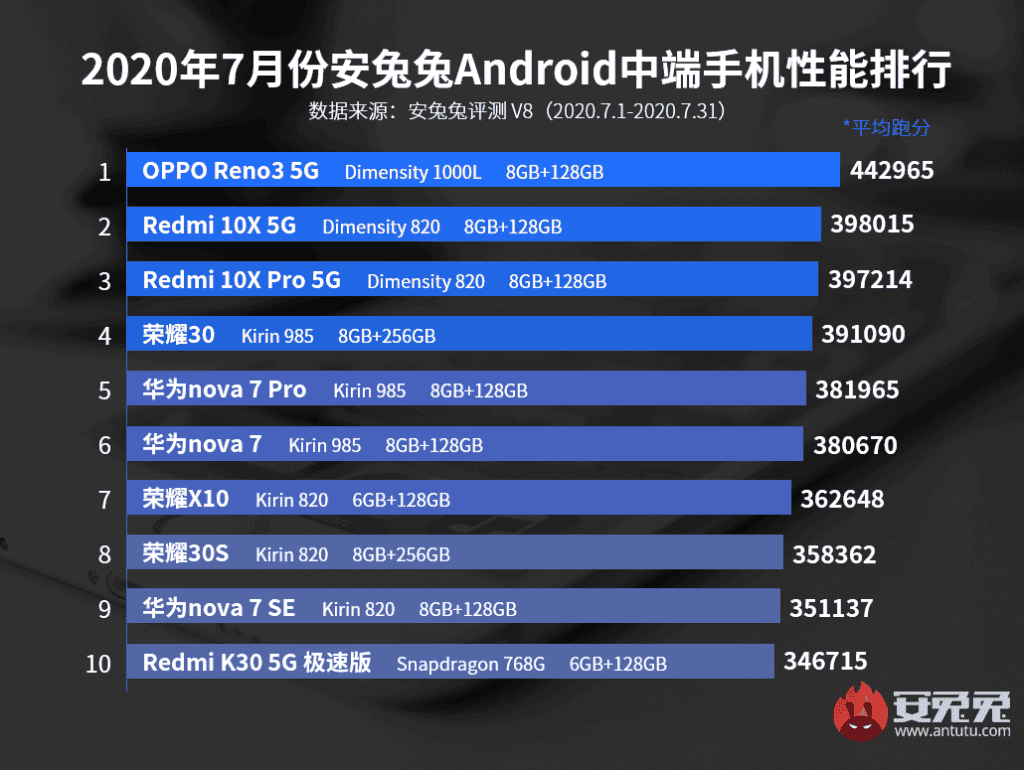For those that find flagship smartphones too expensive to purchase, there are some well-performing mid-range devices that you can consider. Please note that these scores should not be the only criterion for purchasing a phone. However, it will help in making a choice. Here, we have the top 10 mid-range smartphones for July 2020. Please note that this list is inspired by the recently released AnTuTu list of top-performing mid-range smartphones for July 2020. Some of these devices are considered ass “pseudo flagships”. Though they are mid-range, they offer flagship useability. Let us now take a look at the top 10 best performing mid-range smartphones.

Best mid-range smartphones for July 2020 and their AnTuTu scores
- Oppo Reno 3 – 442,965
- Redmi 10X – 398,015
- Redmi 10X Pro – 397,214
- Honor 30 – 391,090
- Huawei nova 7 Pro – 381,965
- Huawei nova 7 – 380,670
- Honor X10 – 362,648
- Honor 30S – 358,362
- Huawei nova 7 SE – 351,137
- Redmi K30 5G speed version – 346,715
Redmi and Huawei/Honor dominates the mid-range segment
In the flagship segment, we saw the dominance of Snapdragon 865 and Oppo / Vivo. Here, only one Snapdragon chip makes it to the top 10 and it is in the tenth position. There is complete dominance of Dimensity chips which occupies the top three positions. Huawei Kirin chips also dominate with six slots on the list. For smartphone brands, it’s all about Redmi and Huawei. Apart from the Oppo Reno 3 in number one position, the other nine slots are taken by Redmi or Huawei/Honor.
Oppo Reno 3
The top three spots on the top 10 mid-range smartphone list is gradually becoming the Reno 3’s birthright. This smartphone has been dominating this segment for many months and it is top again this month. Its average score is 442,965, which is a significant increase relative to the average score of the previous month. This device remains the only smartphone that comes with the Dimensity 1000L. This explains why this smartphone has been top of the mid-range segment. In fact, the Dimensity 1000L SoC is considered as a flagship SoC. Thus, listing the Reno 3 as a mid-range device is a downgrade by the company. No doubt, this smartphone will remain on top of this list for many more months.
Redmi 10X 5G
The second position is occupied by the Redmi 10X 5G with an average score of 398,015. This smartphone comes with the first 7nm Dimensity 820 chip. Just like the Oppo Reno 3, this series will exclusively use this chip for a couple of months. According to AnTuTu’s measurements, this device easily crosses the 400,000. This makes it one of the strongest mid-range smartphones in the industry for now. Nevertheless, it is still behind the Reno 3’s Dimensity 1000L that still relies on the advantages of A77+G77 to beat Dimensity 820 in terms of CPU and GPU. The latter is mainly UX and storage performance.
Gizchina News of the week
Redmi 10X Pro 5G
Third on the list is Redmi 10X Pro 5G with an average score of 397214. This smartphone also comes with a Dimensity 820 SoC like the regular model. Many may be surprised why the Pro model is performing weaker on AnTuTu. The major difference between the Pro model and the regular model is camera and fast charging. The Pro model comes with better camera and fast charging. This deep the overall performance of the device.
Honor 30, Huawei nova 7 Pro & Huawei nova 7
The Honor 30, Huawei nova 7 Pro and Huawei nova 7 occupies the fourth, fifth, and sixth spots respectively. These smartphones also have an average score of 391,090, 381965, and 380670 respectively. All three models come with Kirin 985 chip which explains their similar performance. The CPU and GPU scores are basically the same, so the running scores are almost the same. However, the Honor 30 comes with some optimizations that give it an edge over the others.
Honor X10, Honor 30S and Huawei nova 7 SE
In seventh, eighth, and ninth positions are Honor X10, Honor 30S, and Huawei nova 7 SE respectively. These smartphones scores 362,648, 358,362, and 351,137 respectively. Also, all three smartphones use Huawei’s new Kirin 820 mid-range processor.
Redmi K30 5G speed version
In the tenth position is the Redmi K30 5G speed version from Xiaomi. This is the only smartphone on the list that comes with a Qualcomm chip. The Redmi K30 5G speed edition uses a Qualcomm Snapdragon 768G. The performance of this chip is below Kirin 820 SoC which explains its last position on the list.
Mid-range 5G smartphones are now popular
Looking at the top 10 mid-range smartphones carefully, you will realize that all the smartphones on the list are 5G devices. This shows that 5G SoC in the mid-range market has already been popularized. Also, the price is getting lower but there is still room for cheaper 5G devices to arrive in the smartphone market. As the competition intensifies, chip manufacturers and smartphone brands will reduce their prices. Already, chipmakers are already working on 5G chips for entry-level devices. When this materializes, we will have cheaper 5G phones in the smartphone market.
There is a rapid development in the smartphone market. Specifically, since the advent of 5G, there has been consistent development of cheaper 5G SoC alternatives. Phone makers no longer have to rely on the flagship Snapdragon chips to release 5G smartphones. In fact, flagship 5G chips are quickly losing their relevance. The Mediatek Dmensity lineup is putting up a good fight in the 5G market. It has two new mid-range chips, Dimensity 690 and 720. Presently, these chips are on sale and several manufacturers have adopted them. Already, we have a plethora of low-priced 5G smartphones with these chips. The prices seem to be more friendly, so in the second half of the year, it is worth looking forward to.
Conclusion
Again, Chinese manufacturers dominate the top 10 mid-range smartphones list just like it did the flagship list. Redmi is made for the mid-range market while Huawei (especially Honor) has a good grip on the mid-range market too. Just like we said earlier, the AnTuTu running score should not be the only criterion for choosing a smartphone. The powerful performance is only based on user experience. However, it does not provide feedback on other key factors such as photography, battery life, charging speed, body material/hand feel, etc. Users should comprehensively a smartphone before making the purchase.





I am excited for Dimensity chipsets powered smartphones to launch in India. Can’t wait to witness them in action. Dimensity chipsets is surely to rule the 5G market.